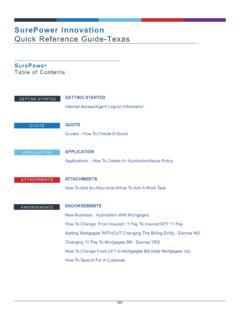Transcription of Electronic Payment System - globip.com
1 Asia Pacific Journal of Finance and Banking Research Vol. 3. No. 3. 2009. Singh Sumanjeet EMERGENCE OF Payment SYSTEMS IN THE AGE OF. Electronic COMMERCE: THE STATE OF ART. Singh Sumanjeet1. University of Delhi, India. E-mail: ABSTRACT. The emergence of e-commerce has created new financial needs that in many cases cannot be effectively fulfilled by the traditional Payment systems. Recognizing this, virtually all interested parties are exploring various types of Electronic Payment System and issues surrounding Electronic Payment System and digital currency. Broadly Electronic Payment systems can be classified into four categories: Online Credit Card Payment System , Online Electronic Cash System , Electronic Cheque System and Smart Cards based Electronic Payment System . Each Payment System has its advantages and disadvantages for the customers and merchants.
2 These Payment systems have numbers of requirements: security, acceptability, convenience, cost, anonymity, control, and traceability. Therefore, instead of focusing on the technological specifications of various Electronic Payment systems, the researcher have distinguished Electronic Payment systems based on what is being transmitted over the network; and analyze the difference of each Electronic Payment System by evaluating their requirements, characteristics and assess the applicability of each System . Key Words: E-Commerce, Payment , Debit Cards, Credit Cards, Internet JEL Codes: E41; L21; O30, O33. 1. INTRODUCTION. As payment2 is an integral part of mercantile process, Electronic Payment System is an integral part of e-commerce. The emergence of e-commerce (table 1). has created new financial needs that in many cases cannot be effectively fulfilled by traditional Payment systems.
3 For instance, new types of purchasing relationships-such as auction between individuals online-have resulted in the 1. Dr. Sumanjeet is an Assistant Professor, Department of Commerce, Ramjas College, University of Delhi, North Campus, Delhi-7, INDIA. 2. Payment represents both cash and non-cash financial transactions, which take place between two or more parties. But, in a strict sense of word Payment ' represents only non-financial transaction. It is more common for two parties exchanging value to hold accounts with alternative banks, in which both banks become the parties of Payment . 18. Asia Pacific Journal of Finance and Banking Research Vol. 3. No. 3. 2009. Singh Sumanjeet need for peer-to-peer3 Payment methods that allows individuals to e-mail payments to the other individual. Recognizing this, virtually all interested parties ( academicians, government, business community and financial service providers) are exploring various types of Electronic Payment System and issues surrounding Electronic Payment System and digital currency.
4 Some proposed Electronic Payment systems are simply Electronic version of existing Payment systems such as cheques and credit cards, while, others are based on the digital currency technology and have the potential for definitive impact on today s financial and monetary System . While popular developers of Electronic Payment System predict fundamental changes in the financial sector because of the innovations in Electronic Payment System (Kalakota & Ravi, 1996). Therefore, Electronic Payment systems and in particular, methods of Payment being developed to support Electronic commerce cannot be studied in an isolation. A. failure to take place these developments into the proper context is likely to result in undue focus on the various experimental initiatives to develop Electronic forms of Payment without a proper reflection on the broader implications for the existing Payment System .
5 Table 1: B2C E-Commerce Sales* in the Select Countries (US Billion). (Asia Pacific Region, 2006-2011). Countries 2006 2007 2008 2009 2010 2011. Australia China** India Japan South Korea Asia-Pacific Note: Converted at average annual exchange rates (projected for future year): Total B2C sales include all purchase made on a retail website, regardless of device used to complete the transaction;. *Includes online travel, event tickets and digital download sales; **excludes Hong Kong Source: eMarketer, January 2008. A. Concept and Size of Electronic Payment Payment systems that use Electronic distribution networks constitute a frequent practice in the banking and business sector since 1960s4, especially for the transfer of big amounts of money. In the four decades that have passed since 3. Peer-to-peer refers to the design of a service that does not rely on centralized networking services such as (Domain Name System -a unique name of collections of computers connected to networks such as Internet) to connect and users' computers and accounts for the unpredictable accessibility of these end nodes in making connections between the users.
6 Participants in the peer-to-peer network, whether individual or companies, exchange information directly with one another, bypassing central exchanges. In short, peer-to-peer is more of a bazaar what customers will find until he/she get there. 4. BankAmerica, in Fresno, California, executes the first mass mailing of credit cards in (1960);. Westminister Bank installs first automated teller machine (ATM) at Victoria, London Branch in 1967. 19. Asia Pacific Journal of Finance and Banking Research Vol. 3. No. 3. 2009. Singh Sumanjeet their appearance, important technological developments5 have taken place, which on the one hand have expanded the possibilities of Electronic Payment systems and on the other hand they have created new business and social practice, which make the use of these systems necessary.
7 These changes, naturally, have affected the definition of Electronic payments6, which is evolving depending on the needs of each period. In its, most general form, the term Electronic Payment includes any Payment to businesses, bank or public services from citizens or businesses, which are executed through a telecommunications or Electronic networks using modern technology. It is obvious that based on this definition, the Electronic payments that will be the objects of present result, are the Payment that are executed by the payer himself, whether the latter is a consumer or a business, without the intervention of the another natural person. Furthermore, the Payment is made from distance, without the physical presence of the payer and naturally it does not include cash. By providing such definition for the Electronic Payment System , researcher include the transfer of information concerning the accounts of the parties involved in the e-commerce transactions, as well as the technological means of distribution channels through which the transactions is executed.
8 Size of Electronic payments : Electronic Payment System is conducted in different e- commerce categories such as Business-to-Business (B2B), Business-to-Consumer (B2C), Consumer-to-Business (C2B) and Consumer-to-Consumer (C2C). Each of which has special characteristics that depend on the value of order. Danial, (2002). classified Electronic Payment systems as follows: Micro Payment (less than $ 10) that is mainly conducted in C2C and B2C. e-commerce. Consumer Payment that has a value between $ 10 and $ 500. It is conducted mainly in B2C transactions. 5. In the year, 1967, the New York Clearing House launched CHIPS (Clearing House Interbank Payment System ) which provides US Dollar funds transfer and transactions settlements online and in real time. In the late 1970s, Chemical Bank launched its Pronto System providing 3,000 computer terminals to customers' home linked to its central computers by telephone.
9 It offers a range of facilities: balance inquiries, money transfer between Chemical Bank accounts, and bill payments to selected local stores. The stumbling blocks for the first generation home building System in general was who is to pay for terminals at home. In the year 1985, EDI ( Electronic Data Interchange) extensively used in bank-to-bank Payment systems. In 1994, digital cash trails by DigiCash of Holland conducted online. And in the year 1995, Mondex Electronic currency trails begin in Sweden, England. 6. A real revolution in the meaning of Electronic Payment System came with the development of EFT. ( Electronic Fund Transfer) technology. EFT is a technology (one of the Electronic commerce technologies). that allows the transfer of funds from the bank account of the one person or organization to that another.
10 EFT is also used to refer to the action of using this technology. It is an important addition in organization that implements EDI in their organization. Consequently, the online remittance of funds appeared to be the next logical step in a progressive move towards the Electronic funds transfer and banking, a process that had begun long before the Internet itself. There is, however, a crucial distinction between the pre-Internet Electronic fund transfer System and the online Payment System being used and developed in the conjunction with e-commerce. The former took place almost exclusively over proprietary networks, which the latter occur over a publicly accessible Electronic medium. 20. Asia Pacific Journal of Finance and Banking Research Vol. 3. No. 3. 2009. Singh Sumanjeet Business Payment that has the value more than $ 500.







